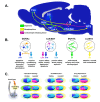Sex differences in the neural mechanisms mediating addiction: a new synthesis and hypothesis
- PMID: 22676718
- PMCID: PMC3724495
- DOI: 10.1186/2042-6410-3-14
Sex differences in the neural mechanisms mediating addiction: a new synthesis and hypothesis
Abstract
In this review we propose that there are sex differences in how men and women enter onto the path that can lead to addiction. Males are more likely than females to engage in risky behaviors that include experimenting with drugs of abuse, and in susceptible individuals, they are drawn into the spiral that can eventually lead to addiction. Women and girls are more likely to begin taking drugs as self-medication to reduce stress or alleviate depression. For this reason women enter into the downward spiral further along the path to addiction, and so transition to addiction more rapidly. We propose that this sex difference is due, at least in part, to sex differences in the organization of the neural systems responsible for motivation and addiction. Additionally, we suggest that sex differences in these systems and their functioning are accentuated with addiction. In the current review we discuss historical, cultural, social and biological bases for sex differences in addiction with an emphasis on sex differences in the neurotransmitter systems that are implicated.
Figures





References
-
- Koob GF, Le Moal M. Drug abuse: hedonic homeostatic dysregulation. Science. 1997;278:52–58. - PubMed
-
- Lynch W, Roth M, Carroll M. Biological basis of sex differences in drug abuse: preclinical and clinical studies. Psychopharmacology. 2002;164(2):121–137. - PubMed
-
- Carroll ME. et al.Sex and estrogen influence drug abuse. Trends Pharmacol Sci. 2004;25(5):273–9. - PubMed
-
- Homer. In: Trans. Fitzgerald R, editor. Farrar, Straus & Giroux, New York; 1998. The odyssey; p. 59.
Grants and funding
LinkOut - more resources
Full Text Sources

